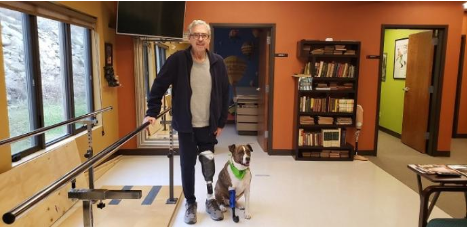Our most famous employee, Keating, who just happens to be an amputee therapy dog, has been hard at work recently. He has been testing out a few of his new 3D printed legs and received some recognition for it in a segment of This is Home on WTAP news.
Our goals at Miller Prosthetics and Orthotics are very high, one of those goals is being able to jump into the future of helping our patients with more technology. Technological advances, like 3D printing, can increase efficiency and accuracy to help us get a patient up and walking in as little time as possible. To achieve this, we will need plenty of practice, which is where Keating comes in. Like many of our patients, Keating needs a custom device that will help improve his gait and overall ability to walk, so we decided to start practicing on the furry guy who is always laying around at the office.

In the WTAP news segment of This is Home, owner and CEO, Nancy Miller describes how she has always had the goal of 3D printing a leg for Keating and all the help she has received along the way. With guidance from Rick Sevier of Steampunk Bionics and Logan Mace at the Makerspace of WVUP, she was able to successfully get Keating up and running on a fully 3D printed socket. There are many challenges that arise during this process, such as learning the new technology of 3D design, and then 3D printing on top of that. The next challenge would be integrating the new technology with prosthetic design, which is actually more difficult for a dog than a person. With a human patient, they can try out a device and give you feedback (with actual words) on how the device feels, whether it is a socket, a brace, or a custom insert. The feedback is very important on getting a device dialed into perfection, because the patient is the one wearing the device, they are the only one who truly knows how it feels. When Keating puts on a new socket, he either walks on it or he doesn’t. After walking on the socket, we can look at his residual limb and inspect it for any sore spots, but this is much harder than being able to talk to the patient to learn exactly what is going on.
There are many different factors that lead to a comfortable socket, first being the shape of the socket. With a 3D scanner, we can take an exact scan of Keating’s residual limb which can then be translated into a 3D model in a design program on the computer. This is a very efficient way of obtaining a positive model of the limb, which is used to build the socket around. Up to this point, we have saved time and material compared to tradition techniques as well as increased the accuracy and precision of the model. The next challenge is the alignment of the foot compared to the socket. In most cases, this step involves the most precision because the slightest change in the positioning, angle, or rotation of the foot compared to the socket can make a huge difference. With Keating, we must get creative because we are not able to use adapters that we would normally integrate into a person’s socket. These adapters allow for adjustability in all three planes of the body. Now with the 3D printer, we can create adapters that we can utilize for Keating’s socket to adjust the alignment. Paying attention to all of this, Nancy was able to combine prosthetic knowledge with the help of Mark Miller CPO, and 3D design with the help of Rick Sevier and Logan Mace, to put together a fully 3D printed prosthesis that works well for Keating.
The video produced by WTAP is not only a great display of Keating’s story and how we are integrating 3D technology into our practice, but also shows the positive affect Keating has on patients. Our goal is to be able to use 3D printing more for our human patients, starting with 3D printed foot orthotics. Keating helped us learn a lot about this field in the design and production of his newest leg, but this is only the beginning. Stay tuned to hear about our advances in treating our patients and check out Keating in his segment on WTAP news This is Home.
Rick Sevier, Steampunk Bionics- http://steampunkbionics.com/
Logan Mace, WVUP Makerspace- https://www.wvup.edu/entrepreneur-opportunities/
